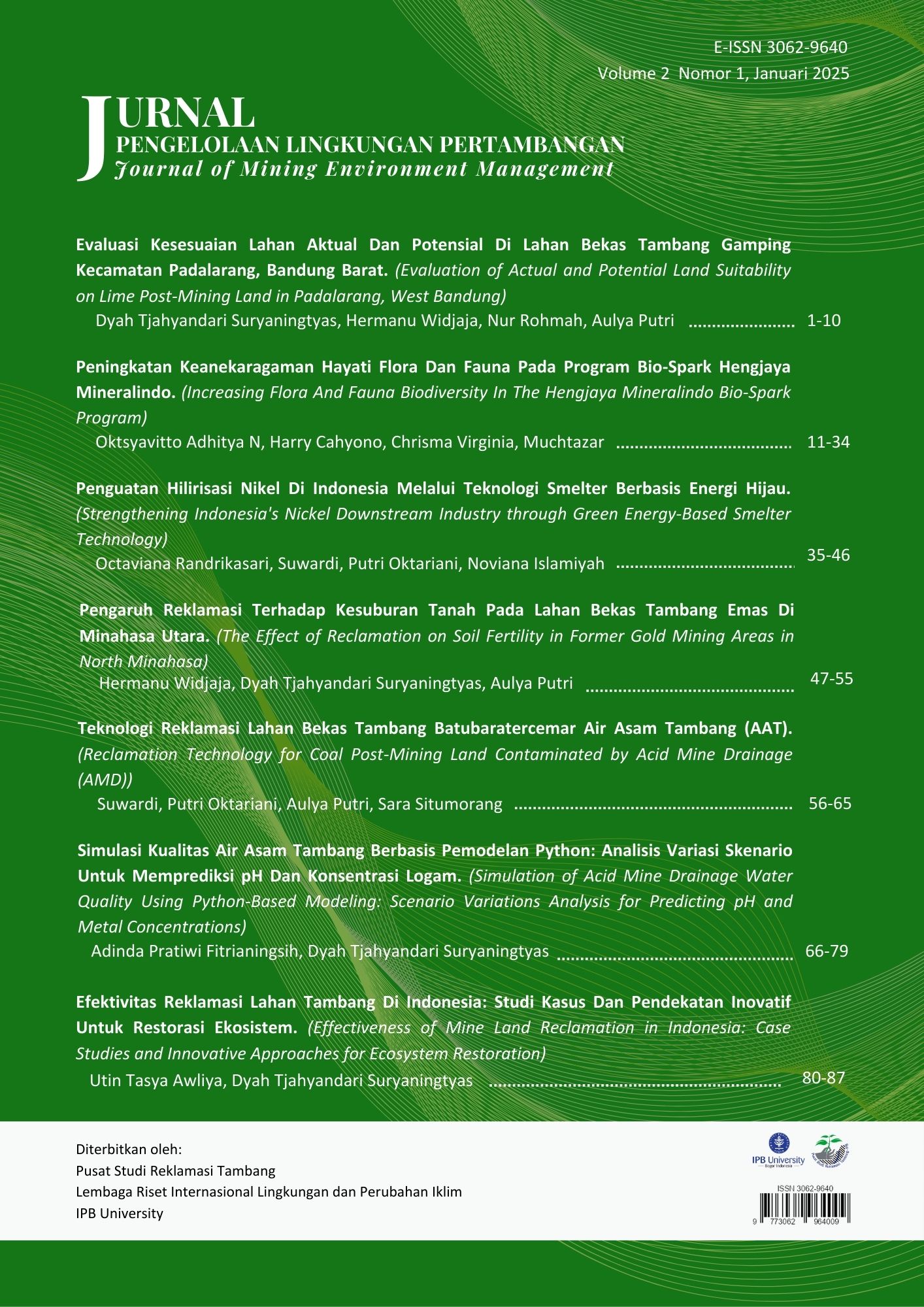Simulation of Acid Mine Drainage Water Quality Using Python-Based Modeling: Scenario Variations Analysis for Predicting pH and Metal Concentrations
Abstract
Acid mine drainage (AMD) is a serious environmental challenge caused by the oxidation of sulfide minerals, resulting in water with low pH and high concentrations of heavy metals such as Fe, Al, and SO4. This study aims to simulate and evaluate mine water quality under various AMD management scenarios based on a Python-based modeling approach. Ten scenarios were analyzed, including mineral precipitation methods, coagulant addition, temperature adjustments, flow rate increases, and industrial pollution impacts. The simulation results show that Scenario B (Goethite and Gibbsite precipitation) and Scenario C (amorphous phase precipitation of Al(OH)3 and Fe(OH)3) effectively reduce aluminum and iron concentrations to moderate levels while maintaining stability. Scenario H (coagulant addition) proved to be the most effective, reducing aluminum concentration to 4.35 mg/L. In contrast, Scenario J (increased flow rate) had a detrimental impact, significantly increasing Fe and SO4 concentrations to 319.12 mg/L. This study applies an integrated approach that combines mineral precipitation and coagulant addition to provide an effective and sustainable solution for AMD mitigation. These findings offer a practical framework for improving environmental management and minimizing the ecological impact of acid mine drainage
References
Akcil, A. and Koldas, S. (2006). Acid mine drainage (AMD): Causes, treatment, and case studies. Journal of Cleaner Production, 14(12–13), 1139–1145. https://doi.org/10.1016/j.jclepro.2004.09.006
Alonso, A. and Gualtieri, C. (2020). Python in hydrology and hydroinformatics: An introductory overview. Environmental Modelling & Software, 126, 104633. https://doi.org/10.1016/j.envsoft.2019.104633
Alloway, B. J. (2013). Heavy Metals in Soils: Trace Metals and Metalloids in Soils and Their Bioavailability (2nd ed.). Springer.
Amoo, O. T., Makupula, N., Akinola, I., & Nakin, M. D. V. (2024). Impacts of flow regime characterization on selected water quality parameters in Mthatha River catchment. In Water Practice and Technology, 19(5), 2158–2174. https://doi.org/10.2166/wpt.2024.103.
Balci, N., Shanks, W. C., Mayer, B., & Mandernack, K. W. (2007).
Bacterial and chemical oxidation of pyrite: Geochemical and isotopic evidence from the laboratory and field experiments. Geochimica et Cosmochimica Acta, 71(15), 3796–3811.
https://doi.org/10.1016/j.gca.2007.04.017
Cassee, F. R., Groten, J. P., & Feron, V. J. (2009). Environmental and Health Impact of Heavy Metal Pollution from Industrial Sources. Environmental Toxicology and Chemistry, 28(6), 1225–1232.ak
Drever, JI. (1997). The Geochemistry of Natural Waters: Surface and Groundwater Environments (3rd ed.). Prentice-Hall.
Forstner, U. and Wittmann, GT. (1983). Metal Pollution in the Aquatic Environment. Springer-Verlag.
Gonzalez, J. Martinez, R. and Ortiz, F. (2020). Simulation of metal concentration dynamics in mining-impacted rivers using Python. Journal of Environmental Management, 270, 110871. https://doi.org/10.1016/j.jenvman.2020.110871
Kumpel, T. and Vörösmarty, CJ. (2017). Global Assessment of the Performance of Water Treatment Coagulants for Removal of Heavy Metals from Contaminated Water. Water Research, 113, 261–271.
Lehtoranta, J. Vilhunen, S., Vepsäläinen, M., Kalliokoski, T., & Martikainen, M. (2015). Efficiency of Coagulants in the Removal of Heavy Metals from Wastewater: A Comparative Study. Environmental Technology, 36(24), 3141–3150.
Lenz, M., Van Ael, E., & Verstraete, W. (2008). Impact of Flow Rate on the Dynamics of Water Quality in River Ecosystems. Environmental Science & Technology, 42(6), 2125–2131.
Miller, ME. and Yager, LM. (2017). Effect of Temperature on the Solubility of Heavy Metals in Freshwater Systems. Environmental Science & Technology, 51(12), 7313–7321.
Nordstrom, DK. (2011). Mine waters: Acidic to circumneutral. Elements, 7(6), 393–398. https://doi.org/10.2113/gselements.7.6.393
Nordstrom, DK. and Alpers, CN. (1999). Phreeqc and acid mine drainage: Applications and issues. In M. J. Gauthier (Ed.), Proceedings of the Fourth International Conference on Acid Rock Drainage (pp. 403–406). Society for Mining, Metallurgy & Exploration.
Pimentel, D. and Burgess, M. (2013). Water Quality and Quantity in River Systems. In Handbook of Environmental Engineering (Vol. 10). CRC Press.
Stumm, W and Morgan, JJ. (1996). Aquatic Chemistry: Chemical Equilibria and Rates in Natural Waters (3rd ed.). Wiley-Interscience.
U.S. Environmental Protection Agency (EPA). Leviathan Mine Superfund Site. Retrieved from https://www.epa.gov/superfund/leviathan-mine
Valente, T (Ed.). (2023). Pollutants in Acid Mine Drainage. 356 pages. ISBN978-3-0365-8329-7 (Hardback); ISBN978-3-0365-8328-0 (PDF). https://doi.org/10.3390/books9783036583280
Xu, T., Zhang, L. and Liu, Y. (2019). Modeling of water quality in mining areas using Python-based simulations. Environmental Science and Pollution Research, 26(24), 24758–24770. https://doi.org/10.1007/s11356-019-05289-7
Younger, PL, Banwart, SA. and Hedin, RS. (2002). Mine water: Hydrology, pollution, remediation. Springer. https://doi.org/10.1007/978-94-010-0610-1.
Copyright (c) 2025 Adinda Pratiwi Fitrianingsih, Dyah Tjahyandari Suryaningtyas

This work is licensed under a Creative Commons Attribution-NonCommercial-ShareAlike 4.0 International License.














